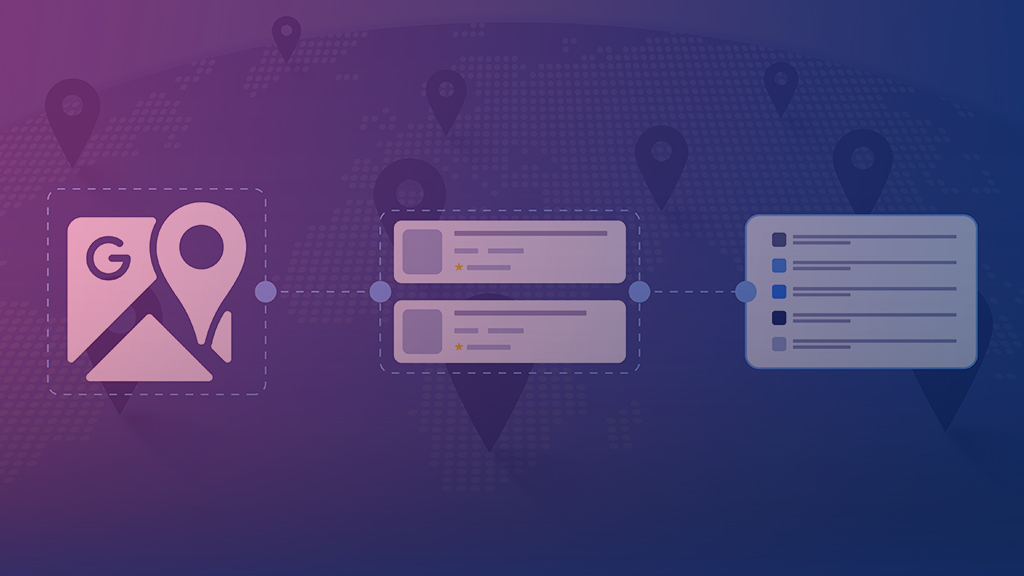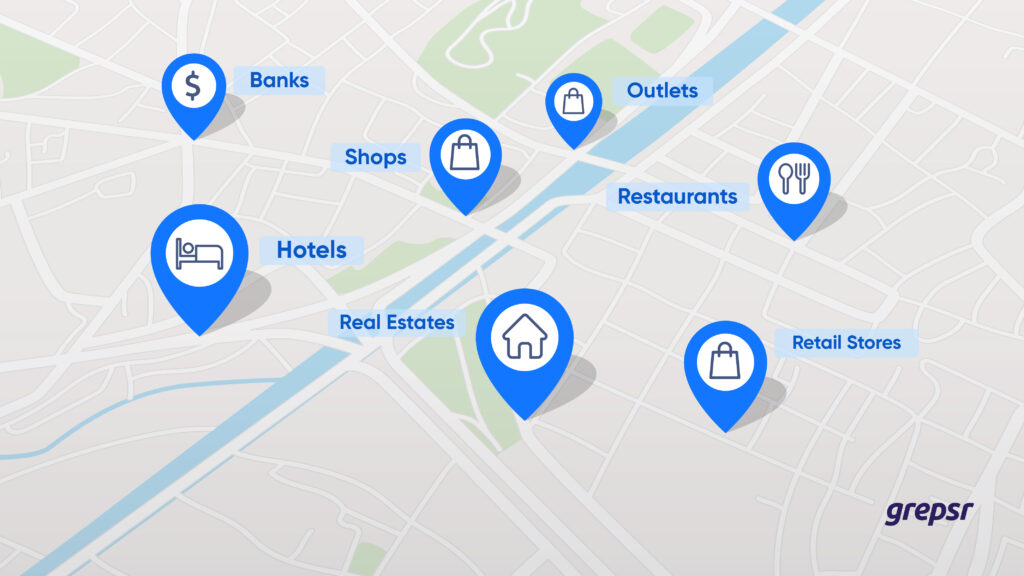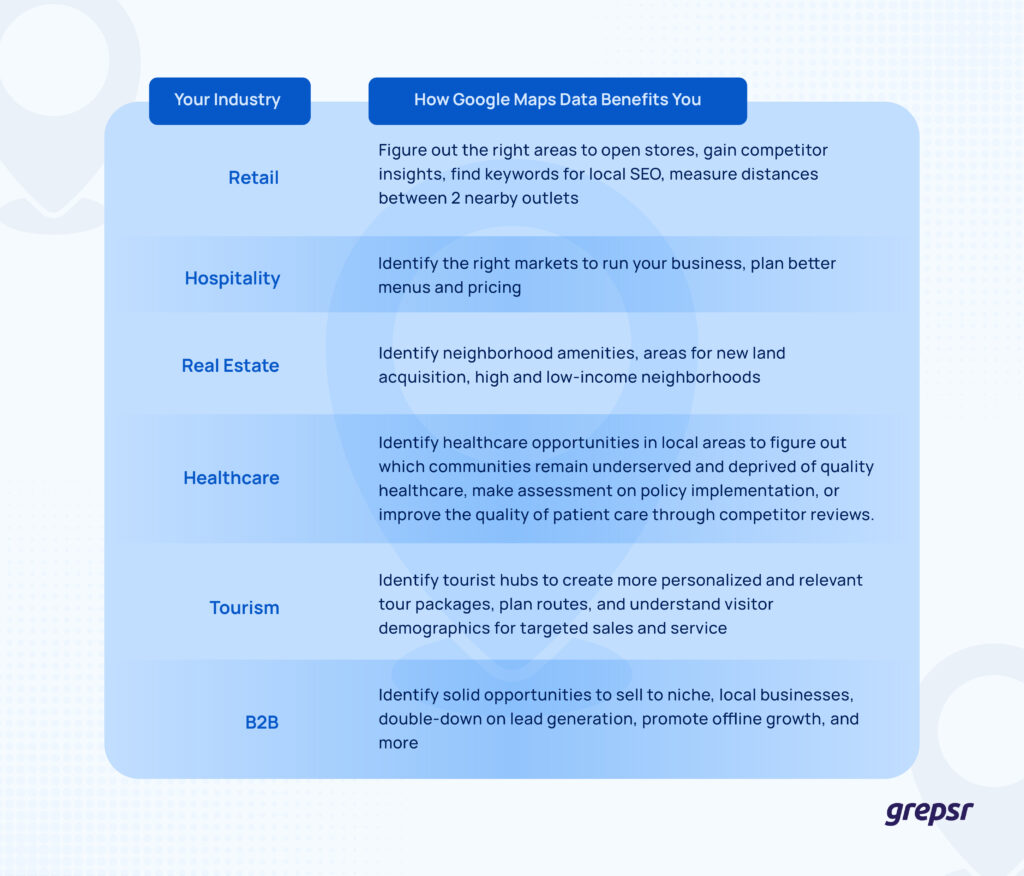
What’s helped you the most in an unknown town in another part of the world? Think of that one app on your phone. Yes, I’m talking about Google Maps—the ultimate assistant to take you places.
Google Maps knows about all the different businesses in your area (the doctors, the chemists, the hospitals, and more) and every other part of the world.
It’s simply full of rich, up-to-date data. Calling it a data mine would be an understatement!
Here are a few facts to put Google Maps’ impressive data prowess in perspective:
In 2024,
- Google Maps has 10 billion+ downloads on just the Google Play Store
- Is used by more than a billion people monthly
- Covers 250+ countries and territories
Imagine digging out scoopfuls of gold from this gigantic data galaxy. Then using that data to improve your business processes. Goes without saying, the sky is the limit here.
That’s what we deal with in this article—explore ethical ways to scrape Google Maps data, understand why it matters for your business, and look at some of its many different use cases.
Sounds interesting? Let’s start.
Why Scrape Google Maps?
Because it contains rich data.
Google Maps is a repository of high-quality point of interest data, such as markets, stores, retail outlets, hotels, and more that can equip your business with a powerful way to make better decisions for your business.
If this isn’t what satisfies you, read on:
- If you’re looking to sell to businesses in specific geographical areas, it supplies you with hot leads, their contact info, and locations.
- If you’re planning competitor analysis, reviews and ratings of your competitors can highlight your competitors’ Achilles’ heel.
- And if you’re looking for geospatial analysis to find ideal business locations, it’s got you covered.
Want to know more? Let’s peek into the benefits of scraping Google Maps up close.
1. For Effective Lead Generation

Let’s say you sell a medical SaaS software that helps hospitals manage critical patient data. You can use scraped Google Maps data in multiple interesting ways to generate new business leads.
How?
Let me give two scenarios:
- Find out what customers are saying about hospitals in location X, let’s say, downtown Chicago. Analyze reviews, and filter out a list of clinics with subpar ratings. Reach out with a personalized email that highlights how they have a bad perception among their customers, and what your business can do to help.
- Find out areas with a high concentration of hospitals. They present a great opportunity for you to market your product offline. Arrange corporate events, schedule product demos, and focus on boosting sales in this region through a strategic approach.
How you use the public point of interest data on Google Maps (or any other platform, for that matter), depends on how well you can imagine how to use it. Literally. There are simply so many untapped possibilities.
But why Google Maps, you may ask?
That’s because Google Maps opens infinite avenues for local lead generation. And local (and offline) B2B lead generation, although often neglected, are super useful strategies for crunching higher sales numbers.
Armed with Google Maps data, you can organize local sales and industry events in the right regions. And guess what? In a Forbes’ survey, respondents said that face-to-face meetings are best for persuasion (91%), leadership (87%), engagement (86%), and decision-making (82%), highlighting the fact that you cannot avoid local targeting.
The takeaway: Google Maps could prove to be a significant source of lead-generation for businesses looking for local leads in any part of the world.
2. Proactive Analytics
Location is powerful for analytics. Location intelligence — answering spatial analysis questions — can lead to new insights and provide new perspectives on things.
David Stodder, Business Intelligence Analyst at TDWI
Google Maps’ geospatial data is an economical solution to leverage real-world data to identify present business risks and make wiser business decisions for the future.
Google Maps data scraping can helps with:
- Geographical density analysis
- Proximity analysis
- Understanding customer sentiment
As a simple use case, think of where to build your next hotel, or open up your new Chinese restaurant. You wouldn’t want to be at a place that’s already too concentrated, or where there would be too few customers, right?
Google Maps data helps with effective decision-making for such business planning scenarios.
Starbucks, the popular coffee chain, leverages location data to precisely determine where it must open new stores. They also use big data to understand which grocery stores would be ideal to sell pre-prepared beverages or even menu updates.
Talking of restaurants, it’s possible to use Maps’ data in more ways than one.
In a study published in the Journal of Multimedia Information System, researchers collected and analyzed 5,427 restaurant reviews via Google Maps Scraping for sentiment analysis. They were able to come up with lists of restaurants under four major categories—taste, service, ambience, and pricing.
While the study concluded with a statement on how “people react more sensitively to dissatisfaction from bad service than satisfaction from good service,” web-scraped data is so much more meaningful than just this singular conclusion the researchers drew from their study.
For instance, it can give you a lot of insights into planning your own menus and pricing, training your staff for better customer service,
Remember, this is just one use case. Maps data is useful across industries, not just restaurants or hospitality.
Some other proactive insights you can gather from Maps’ data: Informed decision-making for supply chain management, geomarketing, or deciding optimal retail store locations.
If you sell flowers, for instance, you can use web-scraped Google Maps data to tell you about the perfect opportunities to open shops, such as near places with religious sites or at crowded markets.
Take the case of SUER, a parcel delivery service operating in Spain. They used geospatial data to figure out, among other things, which regions have high demand, and would thus be better suited to house their distribution centers.
The takeaway: Using Google Maps can reveal interesting foresights that help you make the right business decisions at the right time.
3. Competitor and Market Analysis
What’s common between you and your local competitors? You’re both on Google Maps.
If you’re a B2C business, Google Maps data could be a great place to do some solid competitor research.
It lets you check up on:
- The number of competitors you have in a particular street/town/city
- The number of reviews and ratings your competitors have
- What keywords are they ranking for
With access to high-quality competitor data, you can decide which regions you need to think about more.
For instance, if your business has just a few hundred ratings, whereas your competitor has amassed many more, it’s time to pause and think about what they’re doing better.
Are they offering better services or is it something to do with their pricing? What are customers praising them on in their reviews?
While you may need to analyze competitor’s landing pages or their sales funnel, Google Maps gives you a solid base to start your local competitor research.
The takeaway: You can use Google Maps POI data as a useful approach to analyze competitor reviews, customer sentiment, and operational locations.

4. Identifying Areas for Policy Implementation
In a case study published in the Journal of Information Systems and Informatics, researchers scraped Google Maps to identify the presence of urban facilities in Indonesian villages.
They looked for the number of schools, hospitals, markets, and shops in the region to study the classification of rural and urban villages.
This is solid proof of the fact that Google Maps data surfing could be an effective, low-cost way to gauge and track development parameters in towns and cities. Areas with a high population, for instance, but a lesser number of amenities could be identified and targeted for governmental policy implementation.
The takeaway: Google Maps data can help identify underdeveloped and underprivileged areas for better policy implementation.
5. Better Data = Better Overall Business Growth
Data is the modern manna!
With approaches like data clustering, enrichment, or augmentation, you can tread on the path to data-driven business growth. Opt for better personalization, go for better business planning or accelerate growth with reputation analysis.
The takeaway: Better data translates to better business outcomes.
How Google Maps POI Data Helps Various Industries
When I say Google Maps data helps you, I mean that in earnest. No matter which industry you’re from, spending time scraping Google Maps won’t be time wasted. It will equip you with relevant point of interest data that you can use to grow and amplify your business.
See for yourself. 👇

How to Scrape Data from Google Maps?
Code or no-code? Official API or third-party software?
How you plan to scrape Google Maps depends on your answers to such questions.
Google offers APIs you can use for location and geospatial data. However, using its APIs comes with several limitations. For instance, these APIs are too complex for a non-coding professional to navigate. Plus, these API calls must include an API key linked to a Google Cloud Platform Account.
If you’re looking for a better, easier, and faster way to scrape Google Maps, Grepsr is your friend. Grepsr is a powerful way to web-scrape Google Maps without the need to write several lines of code for prompt access to reliable, consistent, and actionable data of the highest quality.
The Grepsr Google Maps Scraper quickly returns actionable data of your choice, including:
- Titles,
- Map ID,
- Map link,
- Address,
- Latitude,
- Longitude,
- Ratings, and more.
While Google Maps Platform Terms of Service discourage data scraping, scraping publicly-available data for ethical reasons does not violate law. Many businesses often scrape rich data on Google Maps for some of the many reasons we discussed above. So should you.
Ready to Scrape Google Maps?
You know that Google Maps’ data, most of which is coming right from customers, is something you cannot miss out on as part of your data strategy. With the global Location Intelligence Market projected to reach a worth of USD 66.5 Billion by 2032, leveraging Google Maps’ granular insights is not something you can miss out on.
Don’t take our word for it. Scrape data off Google Maps now. Grepsr’s powerful data scraper tools and team of experts will help you take out just what you’re looking for on Google Maps. Whether you need data from parts of a town or scrape larger areas, Grepsr is here to help.







